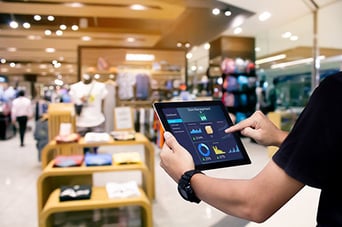Current State of Freight and Inventory Positions
Freight companies are experiencing a decrease in demand for their services, and they are dialing back their expectations for a strong recovery in the second half of the year. Economic uncertainty and signs of caution from retailers are contributing to this trend.
their expectations for a strong recovery in the second half of the year. Economic uncertainty and signs of caution from retailers are contributing to this trend.
The volume of goods moving through supply chains has not met expectations for the beginning of the year, and retail sales figures are causing concern about the direction of the economy. As a result, freight companies are feeling less optimistic than their customers.
Freight demand began to slow in 2022 as consumer spending shifted towards services and retailers found themselves with excess inventory following a rush to stock shelves during the pandemic. Freight companies had anticipated a rebound in the second half of this year as companies returned to pre-pandemic ordering patterns.
However, this outlook now seems less certain as retail sales decline and retailers and their suppliers remain cautious about inventory levels. As reported in WSJ, Nike Inc. has announced that it will continue its reduced purchasing from suppliers as the company focuses on keeping its inventory in check. The sports apparel maker has reported a significant decrease in inventory growth, and the company has slashed its merchandise inventory level by about $400 million from the previous fiscal quarter.
In recent months, U.S. retail sales have been experiencing instability, and the 0.4% drop in February was the third decline in four months. This uncertainty is affecting both retailers and their suppliers as well as freight carriers. According to WSJ, the latest shipping data suggests a decline in demand as companies are holding back on new orders and global trade volumes continue to falter.
Container imports at the ports of Los Angeles and Long Beach, which form the busiest port complex in the United States, dropped 38% year over year in February. Additionally, the Association of American Railroads reported a 5.2% decline in U.S. freight rail volumes during the first 11 weeks of 2023 compared to the same period last year.
The intermodal truck-rail business, which comprises a significant portion of retail traffic, experienced a 9.6% decrease during that time, with the week ending March 18 seeing a year-over-year decrease of 15.2%.
4 Takeaways for Dealing with Increasing Inventories
To help companies navigate these challenges, FCBCO has assembled four areas. It is important to proactively manage your operations and anticipate the changes that could affect your business.
1. Managing Warehouse Inventory
As operations professionals, we can influence decisions that are made regarding inventory. We must proactively report on the inventory and health of the warehouse operations and capacity. For many companies, the timing is unfortunately after inventory has become significantly aged or warehouse space has become a challenge.
It is extremely important to have the proper inventory metrics and KPIs (don't ignore these metrics in the link) in place to help monitor aspects such as warehouse capacity and warehouse inventory metrics. By properly monitoring, measuring and reporting these key metrics, the executive team can make timely decisions regarding inventory positions.
2. Perform a Warehouse Optimization Study
Ensuring the operations are running as smoothly and efficiently as possible is your primary goal. Operations must be dynamic, constantly evolving to support changes in inventory, product and customer expectations.
To ensure that your operations are achieving these expectations, you should consider performing a warehouse optimization study. This is a comprehensive assessment should cover all aspects from the layout and design, to the processes, people and systems in place. Additionally, it should encompass all functional areas of your operations.
3. Analyze Freight and Negotiate with Carriers
As previously discussed, most modes of freight and transportation are down - from containers to small parcels. Now is the time to take advantage of the situation by analyzing your current and future freight, with the idea of driving down costs.
Early indications point to carriers first seeking to reduce costs to bridge the gap between the current slowdowns and a rebound in shipping volumes. However, some modes are getting more aggressive about securing volumes.
Consider rebidding FTL, TL and small parcel carriers, taking advantage of the slowdowns and the desire for carriers to fill capacity.
4. Utilizing Offsite 3PL Storage Options
As inventories grow, many companies will be forced to make the decision of how to support the warehouse and fulfillment functions. When facilities exceed roughly 85% of the available capacity, they are considered "full".
When companies exceed this 85% threshold for extended periods of time, companies end up double handling products and inefficiencies climb. It is important to make timely decisions prior to becoming full. This keeps companies from rushing to a decision, and potentially overspending on storage costs.
Consider the benefits of 3PLs, and how they can help take on some of the storage options. Additionally, 3PLs can help to augment your distribution processes. This could include order fulfillment, value added services, retail/wholesale distribution, and reverse logistics.






SHARE